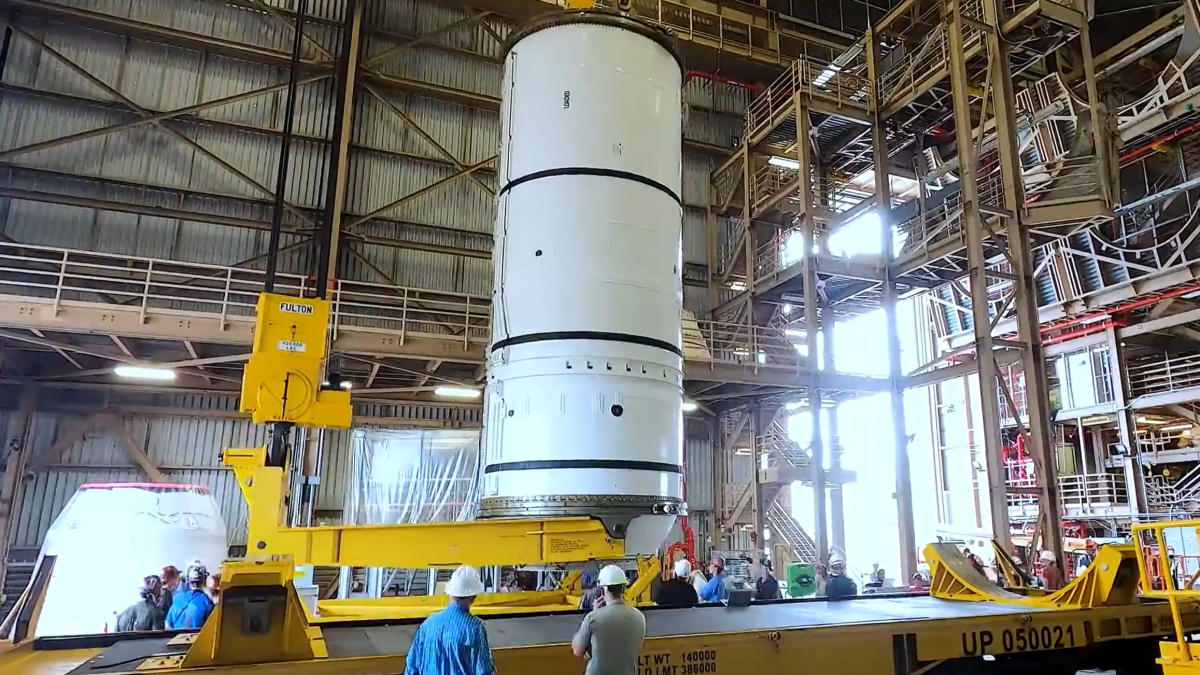A stunning timelapse recently captured the construction of a moon rocket for astronauts at NASA. This rocket, known as Artemis 2, will serve as a powerful boost for NASA’s Space Launch System rocket and is set to launch four astronauts to the moon in 2024. Weighing a staggering 1.6 million pounds, each Northrop Grumman-made solid rocket booster is equivalent to the mass of four blue whales.
The enormous boosters made their way to NASA’s Kennedy Space Center in early October, having been constructed in Utah. Currently, the teams at the space center are focused on assembling the aft assembly of each booster, which plays a crucial role in steering the boosters during their flight during launch.
Moving these colossal pieces within the KSC factory is no easy task, as depicted in the timelapse. Weighing approximately 150 tons each and standing between 26 to 33 feet high, these two-story segments require careful handling. Technicians utilize the facility’s two 200-ton cranes to carefully position and orient each booster segment. Once positioned, the segments are rotated from a horizontal to a vertical position and then moved to the buildup stands.
Once fully assembled, each booster will consist of five segments. While the design is based on the space shuttle program’s booster, it has been modified to accommodate the larger SLS. This modification means that the SLS booster will have five pieces, as opposed to the four pieces found in the shuttle boosters.
The aft assembly work is currently underway at KSC’s Rotation, Processing, and Surge Facility, while other booster pieces are stored nearby. Eventually, all booster segments, both fully assembled and awaiting construction, will be transported to NASA’s iconic Vehicle Assembly Building at KSC. Here, they will undergo further assembly on the mobile launcher, the tower that supports the SLS during launch.
As the mobile launcher is currently occupied with essential testing at Launch Pad 39A, the rocket pieces will remain in storage until it becomes available. Recent testing involved a water deluge test, which assessed the system’s ability to safely handle the shockwaves generated by the powerful SLS and boosters during launch.
Meanwhile, the four astronauts selected for the mission, namely Reid Wiseman, Victor Glover, Christina Koch, and Jeremy Hansen, are undergoing rigorous training to familiarize themselves with the Orion spacecraft. Towards the end of 2023, they will also participate in a splashdown simulation test conducted by the U.S. Navy and NASA officials. The training program, which commenced in April 2023, is expected to take approximately 18 months, allowing the mission teams to develop necessary procedures and hardware while the crew trains.
Artemis 2 serves as a precursor to the anticipated moon landing mission, Artemis 3, which is scheduled for 2025 or 2026. The upcoming mission will involve flying around the moon and returning to Earth, allowing NASA to test the systems of the Orion spacecraft. This historic mission includes several milestones, including Victor Glover becoming the first Black astronaut to venture beyond low Earth orbit, Christina Koch becoming the first woman, and Jeremy Hansen becoming the first Canadian astronaut to participate in such a mission.


